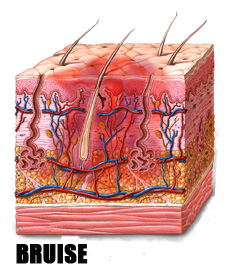Exactly what is a bruise?
Bumps and bruises facts
- A bruise is medically referred to as a contusion.
- Bruises occur when tiny blood vessels are damaged or broken.
- The injury required to produce a bruise varies with age and certain medications.
- Individual bruises change in appearance over time.
- Spontaneous bruising can indicate a serious bleeding tendency.
What is a bruise?
You fall off your bike, bang your shin on the coffee table (that you swore you would move months ago), or run into a wall and wake up with a bruise. What is a bruise, and what can you do about it? A bruise is caused when tiny blood vessels are damaged or broken as the result of trauma to the skin (be it bumping against something or hitting yourself with a hammer). The raised area of a bump or bruise results from blood leaking from these injured blood vessels into the tissues as well as from the body’s response to the injury. A bruise is medically referred to as a contusion. A purplish, flat bruise that occurs when blood leaks out into the top layers of skin is referred to as an ecchymosis.
Why do bruises occur more frequently in some people than in others?
The injury required to produce a bruise varies with age. Bruising occurs more easily in the elderly because their capillaries are more fragile than those of young people. While it may take quite a bit of force to cause a bruise in a young child, even minor bumps and scrapes may cause extensive bruising in an elderly person. Blood vessels become more fragile as we age, and bruising may even occur without prior injury in the elderly.
The amount of bruising may also be affected by medications which interfere with blood clotting (and thus cause more bleeding into the skin or tissues). These drugs include many arthritis medications called nonsteroidal anti-inflammatories (for example, ibuprofen [Advil, Nuprin] and naproxen [Aleve]) and over-the-counter medications, such as aspirin. Warfarin(Coumadin) is often prescribed by doctors specifically to prevent clotting in patients who have had blood clots in their legs or heart. Warfarin can cause severe bruising, especially if the level of the medication becomes too high. Cortisone medications, such as prednisone, promote bruising by increasing the fragility of the tiny blood vessels in the skin.
Patients with inherited clotting problems (such as in hemophilia) or acquired clotting problems (such as in patients with liver diseases like cirrhosis) can develop extensive bruising, unexplained bruising, or even life-threatening bleeding. Sometimes spontaneous bruising is a sign of a bone marrow problem.
What are symptoms and signs of a bruise, and why does it change color?
Bruises can be associated with tenderness of the involved discolored area. Bruises change in appearance over time, and it may be possible to tell by looking at a bruise how old it is. When it first appears, a bruise will be reddish looking, reflecting the color of the blood in the skin. By one to two days, the reddish iron from the blood undergoes a change and the bruise will appear blue or purple. By day six, the color changes to green and by day eight to nine, the bruise will appear yellowish-brown. In general, the bruised area will be repaired by the body in two to three weeks after which the skin will return to normal.

